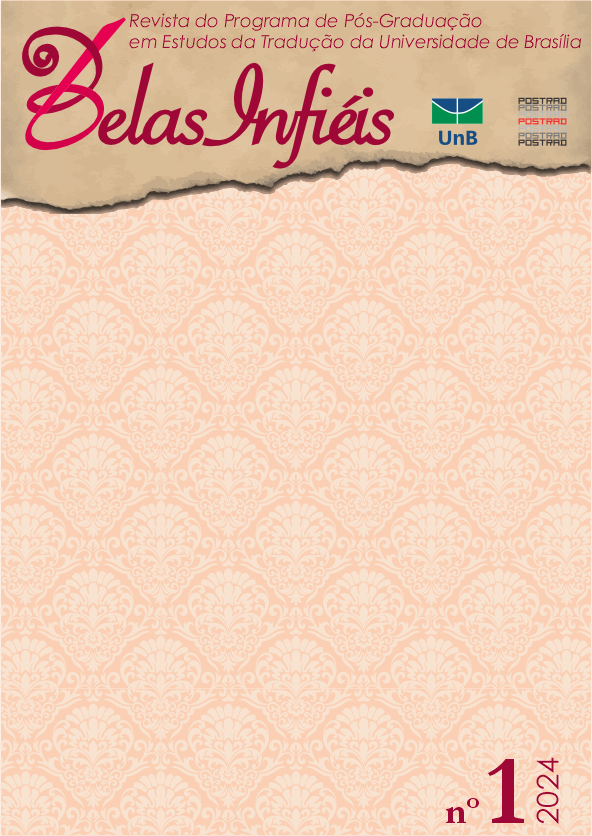The Use of Translator’s Notes in Four Translations of Naguib Mahfuz’s “Miramar”
DOI:
https://doi.org/10.26512/belasinfieis.v13.n1.2024.51312Keywords:
Translation Studies. Paratext. Non-linearity. Egyptian literature. Arab literature.Abstract
Naguib Mahfuz’s novel “Miramar” (1967) portrays urban Egyptian society after the 1952 Revolution and is full of social, political, and cultural references. This type of information can lead to translation problems that may or may not be solved using translator’s notes. Analysing four translations of the novel, to English, Spanish, Brazilian Portuguese, and European Portuguese, it is possible to notice that the translational choices vary significantly, revealing much about each translator, the literary system they are part of, and their relationship with Egypt. In order to investigate the use of translator’s notes in each translation, we use theoretical discussions such as those by María Luisa Donaire Fernández (1991) e Pascale Sardin (2007). I conclude that the English language translation avoids the break of linearity from the main text, being the only translation to not use any form of paratext. In the other three translations, paratexts are used, be they a prologue as in the Spanish edition, which makes some of the translator’s notes unnecessary, or a more frequent use of translator’s notes, as in the two Portuguese language translations. Such notes, most often, fulfill an exegetic function, sometimes also adding interpretative information. In none of the studied cases strategies of explicitation of the translator as author, such as metalinguistic observations, were used. Based on those conclusions and comparing them to the observation of the editorial markets in each of the involved countries, I raise hypotheses about which translation practices are more easily accepted in each culture.
Downloads
References
Cardellino Soto, P. (2015). Abordagens normativas e descritivas às notas do tradutor dos anos 1960 até o presente: excertos de uma revisão bibliográfica. Belas Infiéis, 4(2), 89–96. http://periodicos.unb.br/index.php/belasinfieis/article/view/11338
Fernández, M. L. D. (1991). (N. del T.): Opacidad lingüística, idiosincrasia cultural. In M. L. D. Fernández, & F. Lafarga (Eds.), Traducción y adaptación cultural: España–Francia (pp. 79–91). Universidad de Oviedo, Servicio de Publicaciones. https://dialnet.unirioja.es/servlet/articulo?codigo=1113088
Kassai, G. (1994). Pour un dictionnaire des connotations construit sur les notes du traducteur. Studi Italiani di Linguistica Teorica ed Applicata, 23, 509–521.
Mahfouz, N. (1978). Miramar (F. M. Mahmoud, Trad.). Anchor Books.
Mahfuz, N. (1990). Miramar (F. M. Mahmoud, Trad.). Three Continents Press.
Mahfuz, N. (2002). Miramar (I. Hervás Jávega, Trad.). Círculo de Lectores.
Mahfuz, N. (2003). Miramar (S. A. C. Jubran, Trad.). Berlendis & Vertecchia Editores.
Mahfouz, N. (2012). Miramar (B. Hassanein, Trad.). Civilização.
Newmark, P. (1987). A textbook of translation. Prentice Hall.
Nida, E. A. (1964). Toward a Science of Translating: With Special Reference to Principles and Procedures Involved in Bible Translating. E. J. Brill.
Rónai, P. (1976). A Tradução vivida. Educom.
Sardin, P. (2007). De la note du traducteur comme commentaire: entre texte, paratexte et prétexte. Palimpsestes, 20, 21–136. https://journals.openedition.org/palimpsestes/99
Downloads
Published
How to Cite
Issue
Section
License
Copyright (c) 2024 CC BY

This work is licensed under a Creative Commons Attribution 4.0 International License.
Given the public access to this journal, the texts are free to use but requires the recognition of the original authorship and initial publication in this journal to be properly stated.
 The journal allows the use of works published for non-commercial purposes, including the right to submit the work to publicly accessible databases. Published contributions are the sole and exclusive responsibility of the author(s).Â



















